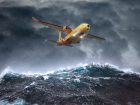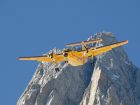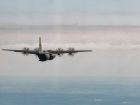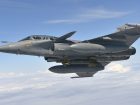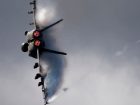
News
Aerospace companies strut their stuff at CANSEC 2017
The global aerospace industry descended on Ottawa in late May for the annual CANSEC Global Defence and Security Trade Show, which is hosted by the Canadian Association of Defence and Security Industries (CADSI).
July 14, 2017 By Joe Atherton
The two-day event is the largest and most important defence industry event in Canada, and it serves as an opportunity for Canadian and global defence companies to strut their stuff when it comes to new innovations, new platforms and products, and new collaborations which are oriented primarily for the Canadian market. Hosted at the EY Centre, this year’s show attracted over 11,000 registrants from 61 countries, and consisted of 700 booths.
The trade show began with Defence Minister Harjit S. Sajjan delivering a breakfast keynote address where he stunned most of the attendees with his direct rebuke of The Boeing Company and its claim that Bombardier is “dumping” C Series commercial jetliners into the U.S. market. That claim initiated an investigation by the U.S. Commerce Department, which in turn has stirred up a political row between Canada and the United States. Boeing’s claim and the resulting fallout has now placed the acquisition of 18 Super Hornet jets as an interim fighter capability solution for the Royal Canadian Air Force (RCAF) in jeopardy.
During his remarks, Minister Sajjan said, “We strongly disagree with the decision of the United States Commerce Department to initiate a trade remedy case in response to Boeing’s petition against Bombardier.” Sajjan went on to say, “Canada is reviewing our procurement involving that firm. As you all know, one of those is the exploration of an interim fleet of fighter jets . . . The interim fleet procurement requires a trusted industry partner.
Now for decades, Boeing has been an outstanding partner with the Canadian Armed Forces, the Government of Canada, and in communities across the country, and I expect that to be the case in the decades to come. However, our Government is of the view that the action against Bombardier is unfounded. It is not the behaviour we expect of a trusted partner, and we call on Boeing to withdraw it.”
Needless to say, this situation left Boeing in a very uncertain position, which caused it to cancel a press conference slated for day two at CANSEC, where the intent was to announce the Super Hornet industry team for Canada.
Reports indicate that the Canadian Government has suspended discussions with Boeing for the time being, so it is therefore unclear as to where the Interim Fighter Capability Project (IFCP) stands at the moment. One option that certainly exists is the Government could seek an alternate solution for the IFCP. This is certainly welcome news for other fighter manufacturers which were displaying their solutions at CANSEC – namely: Dassault Rafale, Eurofighter Typhoon, Lockheed Martin F-35, and the Saab Gripen.
Headline grabbers
Airbus Defence & Space held a substantial briefing which focused on a number of products across their portfolio – notably the C295W, which was selected to replace Canada’s existing CC-115 Buffalo and CC-130 Hercules search and rescue aircraft; and the A330 Multi-Role Tanker Transport (MRTT) aircraft, which could replace the aging CC-150 Polaris strategic tanker aircraft.
Pablo Molina, Head of military aircraft sales for Airbus Defence and Space in Canada provided a detailed overview of the structure of the FWSAR project. “Canada will be receiving the best combination of the latest generation C295W and the latest 3rd generation FITS [Fully Integrated Tactical System] mission system, along with a state of the art operational training unit which will be built in Comox and delivered by our Canadian training partner which is CAE. Airbus is priming the contract, and is acting as a single point of accountability. Our main partner in the country is Provincial Aerospace [PAL], and together we formed a JV [Joint-Venture] named AirPro, which will be the local In-Service Support integrator. AirPro will be responsible of ensuring all the other Canadian partners and suppliers are fully integrated towards the aim of providing the best service to Canada,” said Molina. “The aircraft is the market leader in its segment, and this order consolidates our market presence as the most proven search and rescue platform in its segment nowadays, worldwide . . . We will start cutting metal by the end of June, which is an important milestone. The first delivery is expected at the end of 2019.”
Molina also spoke about the Airbus MRTT, which arguably is the most successful strategic tanker and transport aircraft available on the market today. The aircraft is based on the A330-200 platform, and has the ability to refuel aircraft using hose and drogue, and boom refuelling methods. To-date, a total of 51 A330 MRTTs have been ordered by nine nations (Australia, France, Luxembourg, Netherlands, Saudi Arabia, Singapore, South Korea, the United Arab Emirates, and the United Kingdom), with two (Australia and Saudi Arabia) having already placed repeat orders.
Airbus was keen to note the recent success in demonstrating automatic air-to-air refuelling (AAR) contacts with a fighter aircraft from the tanker’s refuelling boom – the first time in the world that this has been done. Airbus’ A310 MRTT company development aircraft performed six automatic contacts with a Portuguese Air Force F-16 in a demonstration of a technique which the company believes holds great promise for enhancing in-service AAR operations. The system requires no additional equipment on the receiver and is intended to reduce boom operator workload, improve safety, and optimise the rate of AAR in operational conditions to maximise combat efficiency. It could be introduced on the current production A330 MRTT as soon as 2019.
Not to be outdone, Boeing was also keen to speak about their KC-46 Pegasus air-refuelling tanker, which is currently in development for the U.S. Air Force (USAF). The KC-46 is based on Boeing’s 767 airliner.
Glenn Hanbey, global sales and marketing for the KC-46 Tanker Program at Boeing stated that the first KC-46 should be delivered to the USAF “late this year”, however a statement issued in early June by the USAF states that their assessment predicts the first delivery to occur in late Spring of 2018.
Speaking about the potential for Canada to replace the CC-150, Hanbey said, “One of the things they are waiting for is the data packages for the Polaris to see how that aircraft is doing, because just like the U.S. Air Force, they’ve been flying at a much higher rate, so the stress on the aircraft is increased . . . What I’m hearing is they’ll probably extend the life of the Polaris, and at the same time start looking at their analysis of the future replacement for that aircraft. I think the dates are 2021 to extend an RFP or RFI.”
Also present at CANSEC was General Atomics Aeronautical Systems (GA-ASI), which is keenly following Canada’s requirements for a Medium-Altitude Long Endurance (MALE) or High-Altitude Long Endurance (HALE) unmanned platform as per the Joint Unmanned Surveillance and Target Acquisition System (JUSTAS) project requirements.
Speaking to Wings was Aria Mahdion, strategic development representative from General Atomics, who said, “Everyone’s familiar with the MQ-9A Reaper. Now we have the MQ-9B Protector, but our name for it is the SkyGuardian. That’s same aircraft that will be purchased by the U.K. as part of their 16 aircraft Protector program.” GA-ASI predicts the SkyGuardian will be a prime contender for the JUSTAS program.
GA-ASI was also keen to mention a record-breaking event for the company which occurred just prior to CANSEC, where a company-owned MQ-9B SkyGuardian configured in an Intelligence, Surveillance, and Reconnaissance (ISR) “clean wing” mode took off on May 16 from Laguna Airfield at Yuma Proving Grounds, Ariz., with 6,065 pounds of internal fuel. The aircraft flew between 25,000 and 35,000 feet for the duration of the mission and landed 48.2 hours later on May 18 with 280 pounds of reserve fuel.
Lockheed Martin announced at CANSEC that it has successfully completed its Industrial Technological Benefits related to Canada’s acquisition of 17 CC-130J Super Hercules aircraft, the workhorse of the RCAF’s transport fleet. The total project had a value of just under $1.5 billion which includes 77 transactions and specific commitments to Canadian universities and companies of all sizes from across the country. Lockheed Martin was one of the companies that Minister Bains mentioned when he spoke of some Canadian SMEs who benefitted from the Investment Framework awards under the ITB policy.
CANSEC also served as a venue for Field Aviation to mark its 70th anniversary of providing specialized services to the international aerospace industry. “There is no doubt that the name “Field” is recognized as a global leader in the missionization and modification of aircraft”, said Brian Love, Field Aviation’s chief operating officer. “As an aviation company with a long and rich history, we continue to build and strengthen our presence in the U.S. through Field Aerospace, and in Canada and internationally through Field Aviation. We are very proud of our employees across all sites and with what we have achieved.”
Field Aviation achieved international acclaim by the early 2000s for its wide range of capabilities in the modification of regional and business aircraft for missionized operations by designing, manufacturing, testing, certifying and delivering state-of-the-art missionized aircraft. Between 1992 and 2017 alone, Field Aviation has been involved in the creation of 45 special mission aircraft.
PAL Aerospace also announced the development of an On-Demand Intelligence, Surveillance and Reconnaissance (ISR) Special Mission Platform named Force Multiplier that will be available for deployment around the world. According to the company, Force Multiplier fits a variety of requirements for surveillance missions under an on-demand contracting model which will allow customers to rapidly acquire the ISR services they require without owning, operating and maintaining the aircraft platform and required equipment.
PAL Aerospace will own, operate, and provide maintenance for Force Multiplier. In partnership with Thales, Force Multiplier is equipped with the SEARCHMASTER radar and an AMASCOS mission system mainly dedicated for anti-submarine warfare, anti-surface warfare, and high-end ISR missions. With the inclusion of CarteNav’s AIMS Mission System software and Surveillance Information portal, the Force Multiplier Special Mission platform will be equipped with mission system suites which will accommodate a diverse range of applications and customer needs.
KF Aerospace was also in attendance at CANSEC, and was eager to share news that the company has been awarded two contracts by the Department of National Defence which total to approximately $31 million to help maintain the RCAF’s CC-115 Buffalo aircraft for a period of three years, with the option to extend the contract for an additional year; the second contract seeks to maintain the RCAF’s CC-138 Twin Otter fleet for a period of four years, with the possibility of four one-year extensions.
It is clear to see that CANSEC was buzzing with activity as it continues to serve as the premier defence and security exhibition in Canada.
